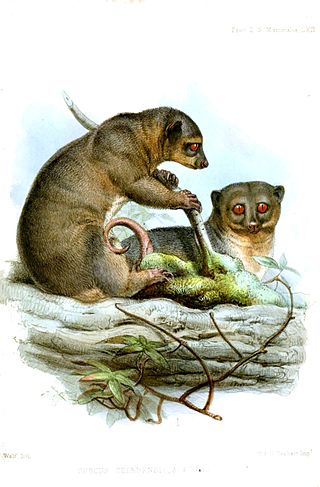
Dibamidae or blind skinks is a family of lizards characterized by their elongated cylindrical body and an apparent lack of limbs. Female dibamids are entirely limbless and the males retain small flap-like hind limbs, which they use to grip their partner during mating. They have a rigidly fused skull, lack pterygoid teeth and external ears. Their eyes are greatly reduced, and covered with a scale.

Dibamus is a genus of legless lizards in the family Dibamidae.
Dibamus nicobaricum is a species of lizard found in the Nicobar Islands of India.

The Celebes warty pig, also called Sulawesi warty pig or Sulawesi pig, is a species in the pig genus (Sus) that lives on Sulawesi in Indonesia. It survives in most habitats and can live in altitudes of up to 2,500 m (8,000 ft). It has been domesticated and introduced to a number of other islands in Indonesia.
The Sulawesi yellow bat is a species of vesper bat. It is found only in Indonesia.

The Sulawesi dwarf cuscus is a species of arboreal marsupial in the family Phalangeridae that is endemic to Sulawesi and nearby islands in Indonesia. It inhabits tropical moist lowland forest and is nocturnal, folivorous and usually found in pairs. S. celebensis is threatened by hunting and deforestation.

The Sulawesi rousette or Sulawesi fruit bat is a species of megabat in the family Pteropodidae endemic to Sulawesi, an island in Indonesia. It is presently the only member of the genus Pilonycteris.
Alfred's blind skink, also known commonly as Alfred's dibamid lizard, Alfred's limbless skink, and Taylor's limbless skink, is a species of blind lizard in the family Dibamidae. The species is endemic to Southeast Asia.
The Timor warty pig is a subspecies of Sus celebensis, or Celebes warty pig. Though described as a separate species, it is a feral form of the Celebes warty pig found in the Lesser Sunda Islands.
Dibamus bogadeki, or Bogadek's burrowing lizard, is a species of legless lizard in the family Dibamidae. The species is endemic to Hong Kong.

Dibamus bourreti, also known commonly as Bourret's blind skink, the white-tailed dibamid, or the white-tailed worm-like lizard, is a species of legless lizard in the family Dibamidae. The species is endemic to Asia.
Dibamus deharvengi is a legless lizard. It endemic to Vietnam and only known from its type locality in Binh Châu forest, Bà Rịa–Vũng Tàu province. The locality is a dipterocarp forest in the Binh Chau–Phuoc Buu Nature Reserve.
Dibamus greeri, also known commonly as Greer's blind skink, is a species of legless lizard in the family Dibamidae. The species is endemic to Vietnam.
Dibamus ingeri is a species of legless lizard in the family Dibamidae. The species is endemic to the island of Borneo.
The mountain blind skink is a legless lizard endemic to Vietnam.
Dibamus novaeguineae, is a legless lizard found in the Philippines, Indonesia, and Malaysia.
Smith's blind skink is a species of legless lizard in the family Dibamidae. The species is endemic to Vietnam.
Dibamus somsaki, also known commonly as Somsak's blind lizard and Somsak's dibamid lizard, is a species of legless lizard in the family Dibamidae. The species is endemic to Thailand.
Taylor's blind skink, also known commonly as the Lesser Sunda blind lizard, is a species of legless lizard in the family Dibamidae. The species is endemic to the Lesser Sunda Islands.
Dibamus vorisi is a species of legless lizard in the family Dibamidae. The species is endemic to Borneo.





